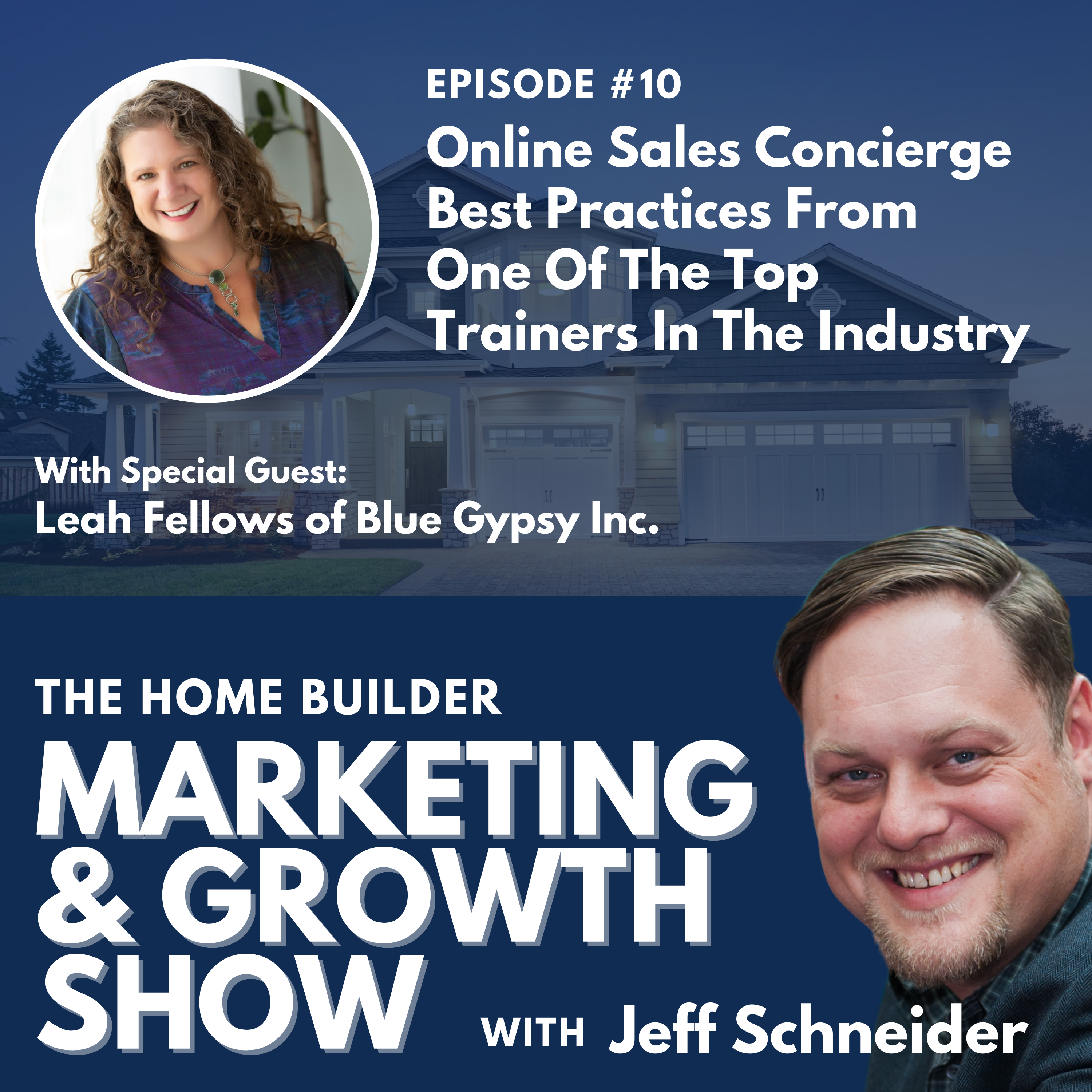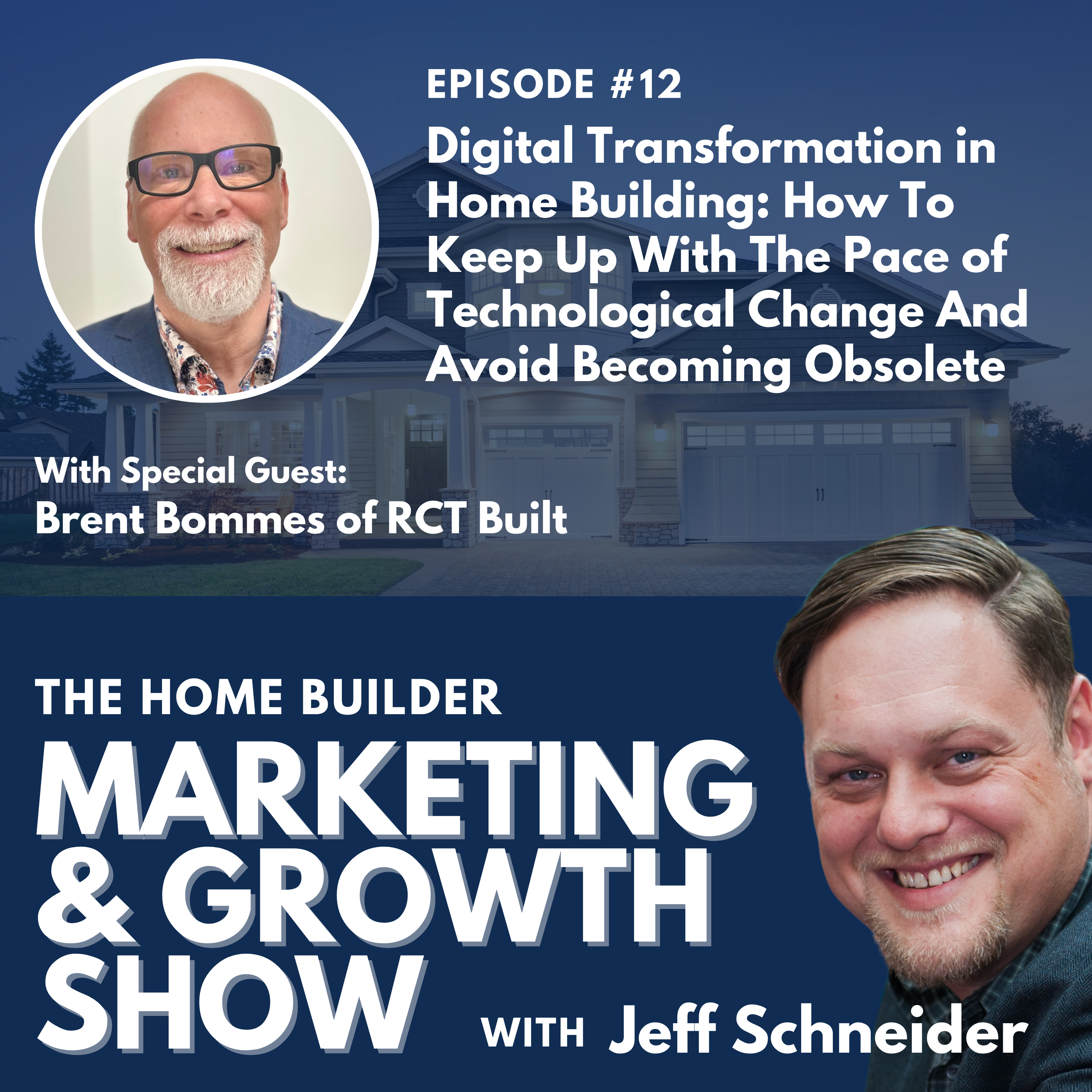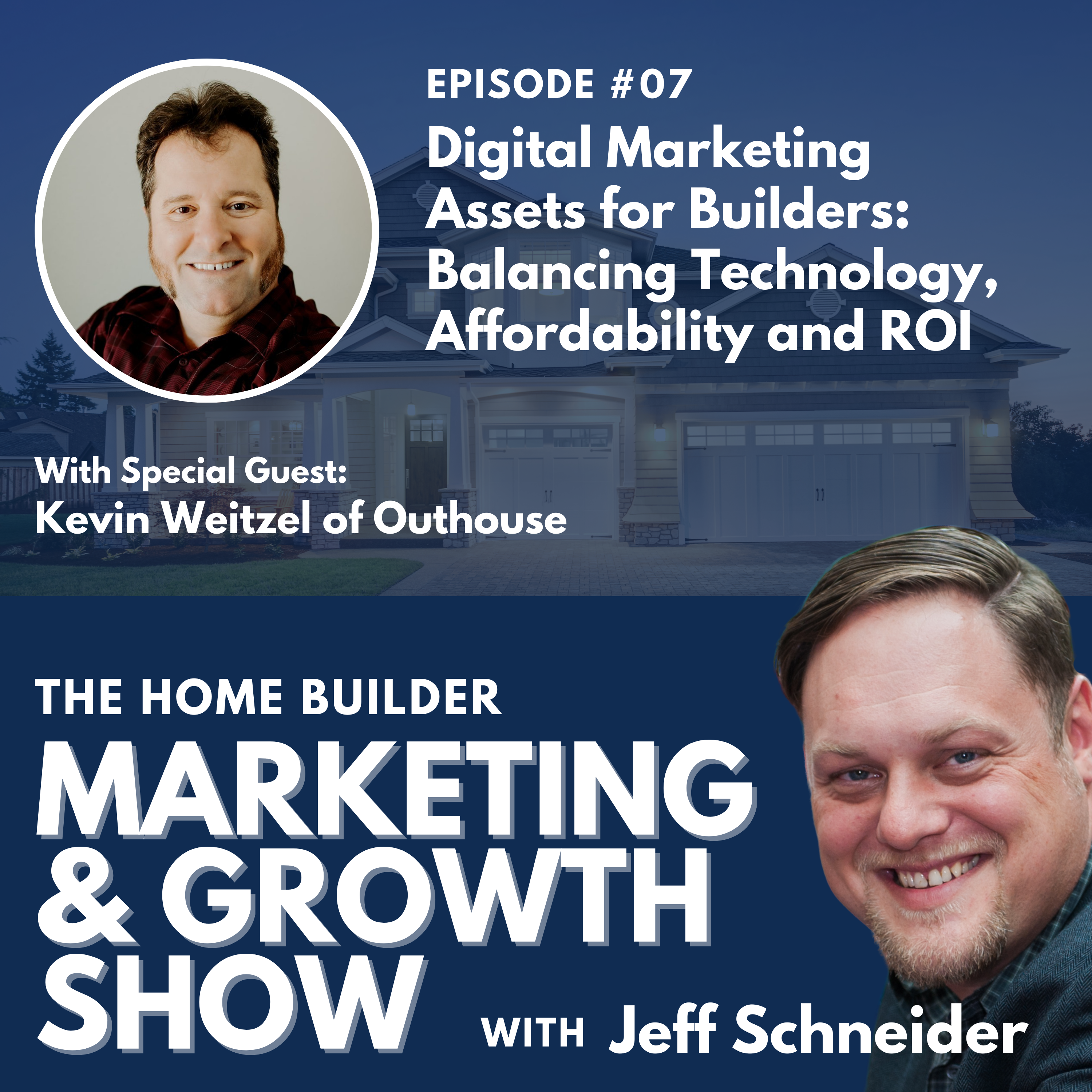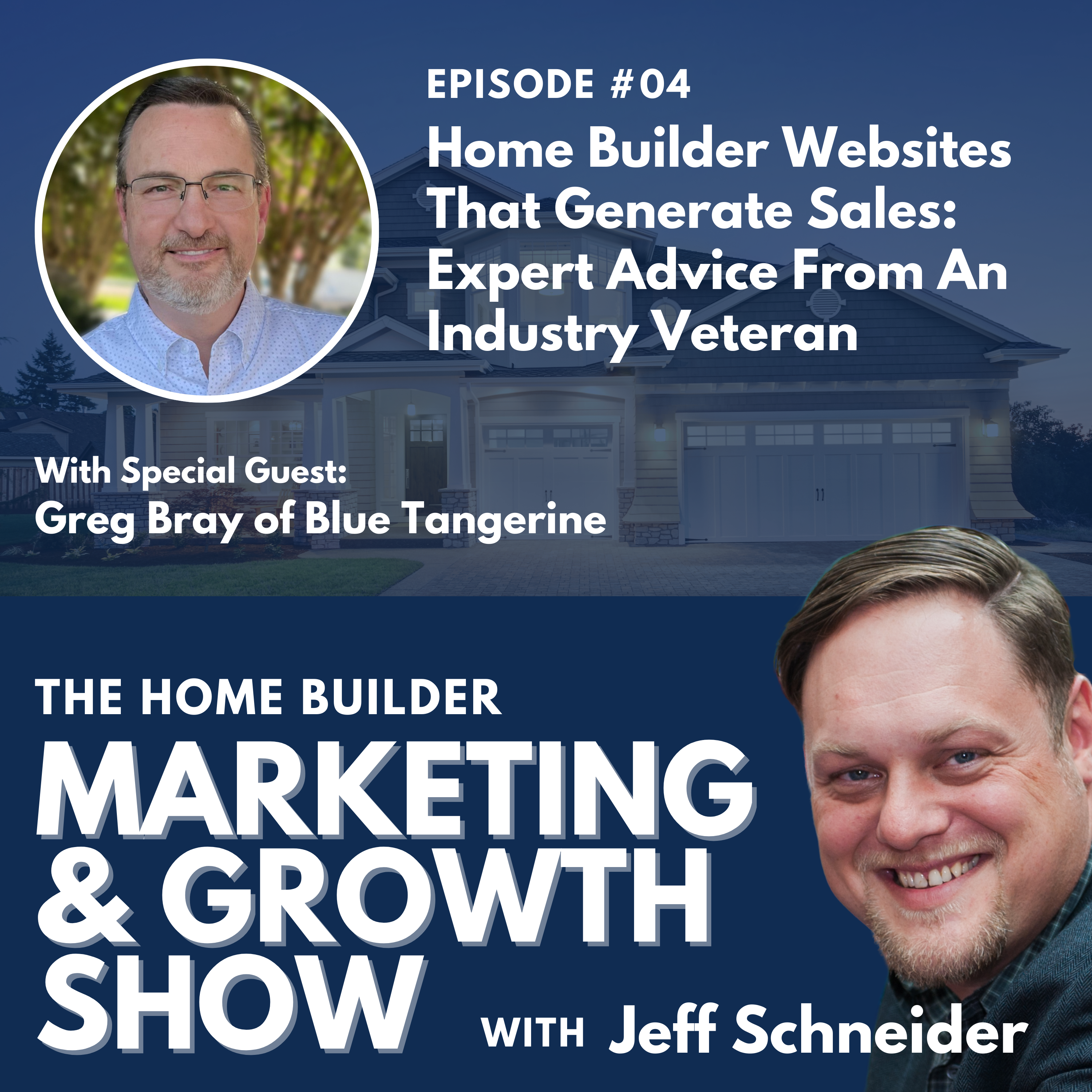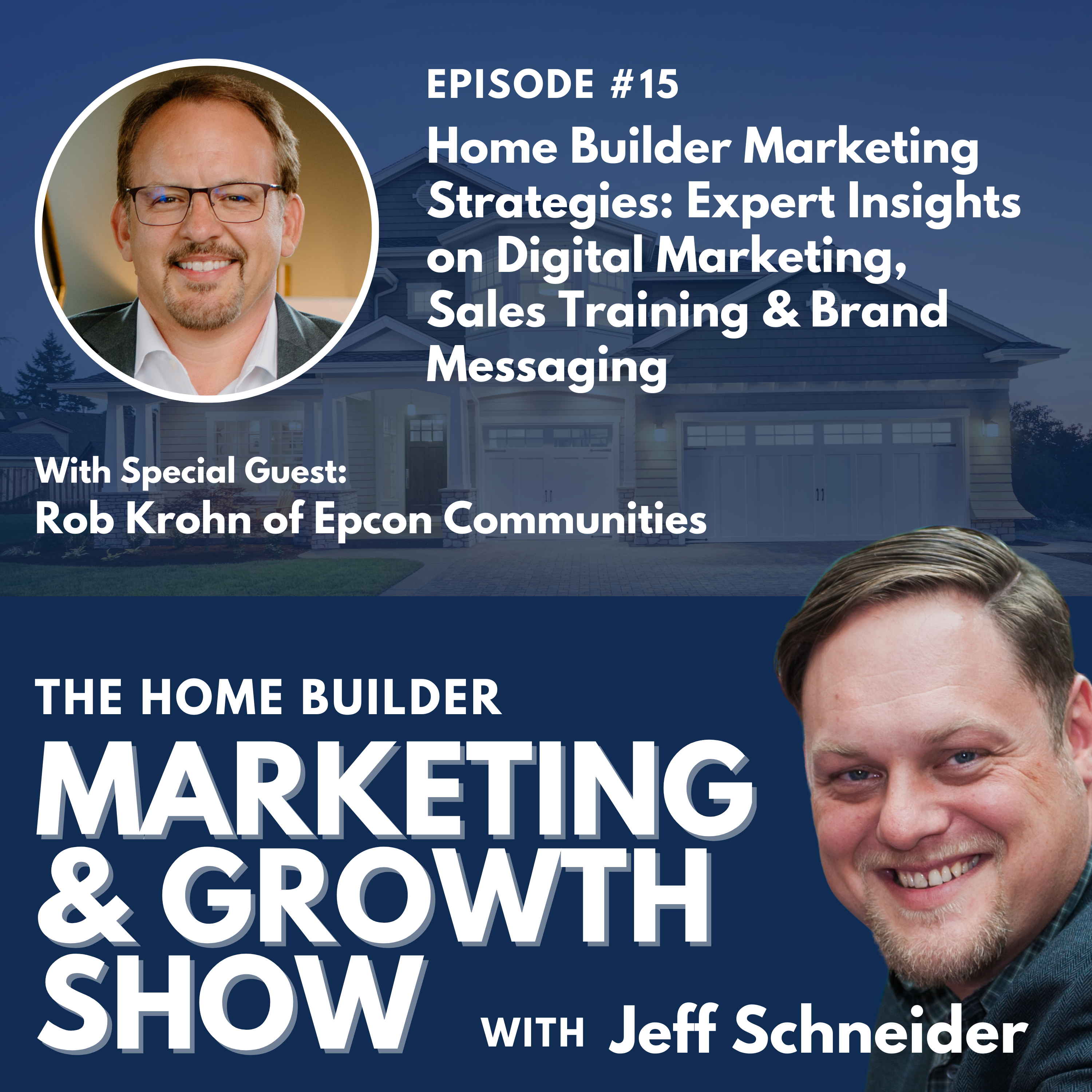Episode Transcript
[00:00:00] Hey, it's Jeff. And welcome to another episode of the homebuilder Marketing and Growth Show. What if I told you that 99% of home buyers that came to your website end up leaving without a way for you to follow up with them? That's right. The typical homebuilder website only converts about half to 1% of visitors into leads. But in this episode of the Marketing Minute, I'm going to show you how to drastically increase those numbers using my favorite lead generation tactic, lead magnets. I've used this approach to generate more than 110,000 home buyer leads. And by the end of this episode, you'll understand how to implement it in your business, too. Sound good? Let's dive in. So what the heck is a lead magnet? Well, a lead magnet is a piece of premium content that you offer to your website visitor in exchange for their email address. Now, this helps you build an email list while providing helpful and useful information to a home buyer that's going to answer their questions and help them move along through their home buying journey with confidence. Now, there's kind of two different types of lead magnets. One of them is generally a lead magnet, which is longer. It's a larger piece of premium content. So this might be something like an ebook or a guide, something with a lot of volume and a lot of depth of information.
[00:01:16] The other type of lead magnet that we refer to is called a content upgrade. And a content upgrade is basically a smaller piece of content. Think of like a cheat sheet or a checklist or a worksheet, something like that that provides utility. And so by providing utility, what I mean is you would offer this on top of some educational information. So maybe you have a blog post on your website where you talk about how to interview home builders so that you can determine which one you want to build with. Well, you might provide a content upgrade. That would be a checklist or a cheat sheet that has the questions that they can print off to ask a home builder to do that interview. So that's the utility component. It basically makes it easier for them to implement the educational information that you just provided to them. So that's a content upgrade. Now, a lot of home builders say, well, you know, we don't really need those, Jeff, because we have a Contact Us form on our website. Well, contact Us forms typically only average about half to 1% conversion rate. And if you're like most home builders, your Contact Us forms, probably a lot of vendors looking to do business with you, and you probably don't get a lot of sales in inquiries through it. So I would say to you that there's way better ways to generate home buyer leads from your website. Now, maybe you have a forum where you can ask your OSC or sales rep a question. We see that on websites all the time, and that's really popular. You know, have questions, contact our osc. The problem with forms like this, though, is that they are totally focused on the bottom of the funnel. They're focused on getting inquiries from people that are nearing the end of their home buying journey and are getting ready to make a buying decision. Now, that's not necessarily a bad thing, and you definitely need to have those. But my challenge to you is, what are you doing for people that are at the beginning of their home buying journey or right smack in the middle of their home buying journey, and they're doing that information gathering and trying to do their research, and they have questions that they need answers to.
[00:03:18] So this is where lead magnets and content upgrades work really well because it allows you to capture the information for prospects that are earlier or in the middle of their buying journey and then you can follow up with them using email marketing, which is an amazing tactic for lead nurturing. Now, if you're familiar with our growth engine framework philosophy, it's important that you use content upgrades and lead magnets to capture people as early in their home buying journey as you can. Because what that allows you to do is stay front of mind with them, to deliver more helpful content to them as they go through their home buying journey, and to position yourself differently than all the competitors in your market. If you're the one that's providing the helpful research to these different home buying prospects, you're positioning yourself as a helpful advisor and an expert when it comes to buying a new home. Unlike all the competitors in your market who are probably only focused on promoting their latest promotion to the people that are buying now today. This tactic will actually put you in front of homebuyers earlier on in the home buying journey than the rest of the competitors in your market. And that's a really great place to be from a positioning standpoint, because you have an opportunity to earn trust and to develop some rapport long before they get ready to make a short list. The other thing that I really like about lead magnets and content upgrades is that there's a psychological trigger involved in this. It's called giver's gain. And so if you give something to somebody that has a perceived value, there is a psychological trigger there that they feel that they owe you something. Now, obviously, just because you give them an ebook or a workbook or a cheat sheet, they're not going to be obligated to buy a home from you. But what we want to do in order to sell more homes is stack as many of these wins as we can in our favor. And so providing content upgrades and lead magnets, you are giving to that home buying prospect and helping them to do that research. You're making that research phase for them that much easier, which ultimately ends up earning you some credibility and building that rapport trust, like I was talking about. All right, so what are some examples of lead magnets and content upgrades? Well, there's a whole bunch of different ways that you can do this. And I've actually put together a free guide for you, a free swipe file that you can download that has a whole bunch of examples of what to do and how to put them together, how to approach this process. If you've never done this tactic before and you can download it and I'll give you the link at the end of the show so that you can download that swipe file and you can start using this tactic right away in your own company. So let's get into some different examples of lead magnets and content upgrades right now. So one example that we've used in the past that we found to be really effective is an area guide or a community guide. And so if you're a builder that builds in multiple new developments around the city or the market that you build in, this can be a really effective lead magnet in that you are kind of giving your home buyer a summary of these different communities. So you're going to talk a little bit about that community, the types of homes that are there. You might include your travel time or commute time to the airport or shopping or that sort of thing. Talk about the different amenities that are nearby. This is a really effective lead magnet when somebody is still trying to determine where in the city that they want to live. And we've used this particular example with a lot of success in the past. Now, the next example are model home lookbooks. So pretty much every builder offers an option on their website on the model page to download a brochure. And when you click on the link, it just opens up in a new tab and there's a PDF. Usually it's just a black and white floor plan and there's not much more information on it. I would challenge you to take some time to develop and design almost like a model brochure. So a model Home Lookbook your going to include the floor plan. You're going to include pictures of a model of that particular floor plan. And I recommend that you have those virtually staged. It's very inexpensive to virtually stage professionally shot photos, so definitely have a look at that because it makes all the difference.
[00:07:32] Then you're going to have some writeups about the different runes and you want to make sure that the write ups really invoke emotion. You we need to use emotion to help people to picture themselves living in this particular model. Don't use a lot of content on these pages. You want to primarily focus on the imagery. That's what's most important.
[00:07:52] And then at the end of that model Lookbook you can put in directions to a show home. If you have one of those models available as a show home, you can put in your standard features and always put in a call to action, which is to talk to an OSC or a sales rep if you're interested in this model. The next example is a Needs versus Wants checklist. So buying a new home is really exciting and we always have this vision of this dream home in our eyes. But unfortunately sometimes budgets don't match with what we want. So we have to make some hard decisions. We have to determine what are the things that are a necessity that we need to have in the home and what are some things that are nice to haves or want to haves that if we can't afford it then we can cut. So creating a Needs versus Wants checklist is really effective and really helpful to a potential home buyer so that they can go through and they can kind of document what's needed and what's just a nice to have or a want. So that's another way that you can help them to narrow down what their new home is going to look like, which is ultimately going to make budgeting that much easier.
[00:08:59] So we found that this type of a content upgrade works really, really, really well. Now the next one is a home builder interview guide. So I mentioned this example already, but when that home buyer is getting ready to shortlist home builders that they want to build with, they need to do interviews with those builders or with those sales reps. So providing that home buyer with a list of questions that they can ask that person and to do that interview saves them a lot of time. And you can create a blog post about the different questions that they should be asking as well as what to look for in the responses that they receive. And then the content upgrade is this downloadable principal home builder interview guide. So this is also very effective and works really well for generating leads. Now, another great content upgrade is a floor plan comparison sheet. And so this is just a worksheet that they can download and print off, and they fill in the information on the different floor plans that they're considering. So it might be floor plans with you, it could be floor plans that you offer compared to other builders that they're considering, but it just has spaces set up like a table where they can put in information and details about the different floor plans that they're looking at. And you might want to package this one up with a bit of a guide to help provide some instructions on how to use this worksheet. But this is also very effective. Okay, so what do some of these examples look like? I'm going to hop into a few examples that we've created now and just kind of walk you through them so you have a visual idea what they look like. If you're tuning into this episode on one of the podcast platforms that doesn't have video, then I recommend that you hop on over to YouTube or check us out on Spotify or Apple Podcasts or one of the other platforms that does have a video associated with it so that you can see the visuals, because they're going to be very helpful when it comes to creating your own lead magnets and your own content upgrades. So this is an example of a home builder comparison checklist. And so this was designed for prominent homes so that their prospects could compare them to the other builders in their market. Now, we designed this sheet to amplify or shine a spotlight on the things that prominent homes felt that they really had a dominant hold on in the market, things that they felt that they did better than everyone else. So the categories that we have on this checklist are things that fall under the home buying process. So were there home models that fit within your budget? Does the builder have a preferred lender? And different information that that prospect needs to understand about the home buying process? Then there's information about finishes and features. Are the finishes and features that you want considered to be standard? Does the builder allow for customization? Are you able to make changes to your home's interior after you sign the purchase agreement? So different areas that they want that prospect to look into when it comes to finishes and features, the next section is quality craftsmanship. So how long has the builder been operating? Do they have safe and clean construction sites? Does the builder use licensed tradespeople? Again, things that they want that prospect to look into that's going to help prominent homes shine above the rest of the people in their market. And then the last one is customer service. Are your questions being answered in a timely manner? Is the builder helpful and knowledgeable? Did you feel comfortable in your first interaction with the builder? And so the idea is that somebody can go through and answer or fill in the questions here and they can total it up at the bottom. And when they do that, they get a numerical value of which builder it is that they should be building with. Now again, a lot of thought went into this because these are all areas that when a prospect compares them to other builders in their market, prominent homes feels like they really shine. So it was a very strategic piece to put together, but this is something that you can do yourself. The next example is a home site assessment checklist that we prepared for copper builders. Now this particular piece does have some information in it. So it does act kind of like a guide. It gives the prospect some things to consider, some helpful information and questions that they need to ask, things they need to look into. And then as we get further down and deeper into this guide, you'll find that there is an actual checklist here. So these are all home site related costs that that home buyer prospect needs to record and needs to budget for. And so they've provided this really handy sheep for that person to fill in this different information for all the costs and budgeting related to assessing that particular home site. Now this next piece is more of a larger lead magnet. It's more of a guide. And this is a piece we put together for Sterling Homes, specifically for their audience that is looking to downsize. So it's called Dreaming about Downsizing. Learn to make the most of your move. And if we go through this document, we see that the there's a lot of information in here that is specifically for somebody who's getting ready to downsize. So if somebody is in that position where, you know, the kids have left the nest and they've got a little bit more home than they need and they want to trim things back a little bit, this guide is super helpful for them. So some of the information that they put in here is, is it time to sell the home? Where are you going to go? What about the retirement years?
[00:14:26] What to consider when you're getting ready to downsize. And you'll notice that these guides are full of links and these links all go to additional information and blog articles on their website. So they act as a way of bringing people, pulling people back into the website. Once again, there's more information about what the process of downsizing looks like. You know, decide on the floor plan that you want, then start to declutter, speak with a professional. So they've really thought out about what that process looks like for a downsizer and have helped to put together this information for them.
[00:15:03] And then lastly, there's a good call to action at the end. So they have an online sales concierge and they've got a link here to connect with that home advisor. So they can just click on that link and it takes them right to that form that they can fill out and get in contact with their osc. And then they also have another option to download another guide which is a little bit further down the home buying journey. So it's designed to help keep people moving through that home buying journey. So this is a really great guide. They did a really great job of it. So the next one that we have here is a needs versus wants checklist. Like we talked about in my examples that we designed for pay setter homes, this guide really turned out great. There's some helpful information in the beginning before it gets into the actual checklist. So you'll have some information here on what needs versus wants are and how to have a clear vision of what you want your future home to look like.
[00:16:00] It's split into nice sections. They use a big font, so it's easy to read and understand. There's information in here on the function of your home and your lifestyle. And then we get into the checklist, there's a little bit more information, and then we get into the needs versus wants. So this is where that person, that home buying prospect, can come in and they can record the information for their needs versus their wants. So for example, maybe when it comes to size, their absolute base need is 2,000 square feet, but ideally they want something that's 2,400 square feet. So they can really put in all the different information into this checklist. And this checklist is super helpful for the home buying prospect, but it's also really helpful for the salesperson because if they bring this checklist in with them, the salesperson has a really clear idea of what it is that that person's after. And there's a bit of a plan for them to follow when they're going through and doing that discovery. There's some additional information on the floor plan, different information around the interior features, some info on the exterior features, what they want nearby in the community that they build in. So community amenities, information about utilities that they need to consider, and then there's even a section where they can put in their own information and then they wind up with good, strong call to action page where they promote another piece of content that's a little bit further down in the home buying journey. In this case, it's the benefits of building a home with pay center homes. So this is more end of, bottom of funnel end of that home buying journey. So they're really helping to move that person along to a sales step if that prospect's ready to do that. So they've done a really great job with this particular guide. Okay, and the last one, and this is probably one of my favorite ones because it's really easy for home builders to implement. This one is a model lookbook. So this is a model lookbook that we put together for a project called Symphony Tower. This is their Mendelssohn unit. This is a high rise condo in downtown Edmonton. And so we put together this guide to kind of highlight and showcase everything that this Mendelssohn model has to offer.
[00:18:14] So we have the floor plan here listed first. Shows the number of bedrooms and bathrooms, which floors this particular model was available on, how many square feet it is. Then we show the floor template so that somebody can see where this particular model is located on that floor in this high rise condo. And then we start getting into the emotional aspect of it. So you can see that we've done great big images here. We've used some fancy writing and we've got some really great copying here. That's very emotional and designed to really sell the sizzle of this particular model.
[00:18:51] And we kind of walk through this particular model step by step. So we're showing off the kitchen first because that's obviously one of the major things that people look at.
[00:18:59] And we've got the living area, we're definitely highlighting the views. That's something that this particular model really had a great selling feature for, was it overlooked the river valley in Edmonton. Another shot of the living area, and again, this particular lookbook, all the images that we used in this, these are all virtually staged. This particular unit was empty. There was nothing in it whatsoever. So we paid a professional real estate photographer to go in, take some photos of it, and then we had our team do the virtual staging on it and place furniture in it in a very tasteful way. And it turned out great. And really for somebody that's just kind of glancing at this, and only to the trained eye, you would never know that this is virtually staged. So why pay for all the costs of staging a different property? When you're just trying to create digital assets, you can have something like this virtually staged and it costs pennies on the dollar. It's very inexpensive to do virtual staging. Another shot of the living room. More of a write up about the open living. We got a shot of the dining room and the office that this one had, or the den. Picture of the luxury bathroom. Photo of the master bedroom with the patio outside.
[00:20:14] Nice big walk in closet.
[00:20:17] Let me get into the standard features that are available in this particular unit. So they're all listed here at the top. And then the ones that we really wanted to focus on, we took pictures of and have those listed as well. So it really kind of draws in the eye to those particular features that we felt were really important. And then you got your nice lifestyle shot. And then some more information about Symphony Tower.
[00:20:42] All right, so there's some examples of effective lead magnets and content upgrades. So how do you get started with doing this in your own company? That's a great question. And what you should focus on first is go through your top pages on your website and those are the pages that you want to design a lead magnet or a content upgrade for first. So typically for a home builder, these are going to be your pages that have to do with your communities and your floor plans and sometimes your about page. So those are the pages that tend to get the most traffic.
[00:21:11] What you want to do is identify on each page what type of lead magnet or content upgrade is relevant to the content on the page and makes sense, but it's also going to provide value to the visitor. And so this is why I'm such a big fan of model lookbooks, because our model pages tend to get the most traffic out of every other page on our website. And those are prime pages for us to be able to generate leads from.
[00:21:37] So one of the things that I recommend that you do before you get started with creating lead magnets is map your buying journey. You, you want to make sure that you have lead magnets at all the different decision points or key milestones along that buying journey. What that allows you to do is collect additional leads at all those decision points. And that's powerful because those decision points are places where home buying prospects are typically looking for information, doing research. So those are great opportunities or great conversion points for you. Once you've mapped out and created your lead magnets and content upgrades, we have to get them into the hands of the buyers. So how exactly do we do that? Well, to start off with, you want to have what's called a call to action. So this is typically a button or a banner on your website that when the visitor clicks on, it's going to either take them to a landing page or it's going to open up a pop up window on that landing page or on that pop up window will be a web form that they can fill in. So first name and email address. Typically when they fill that information in, they're going to receive an automated email from you that says, hey, thanks so much. Here's a link to download your resource and it's that simple. So in order to do that, you're going to need some software. If you're a HubSpot user, you already have this software within your tool if you're using the marketing hub. And if you don't, then one of my favorite tools to do this is called Convertbox. You can check out Convertbox by going to velocity23.com convertbox I'll put a link to it in the show notes for you. Not only does convert box look good, but they have all different kinds of triggers that you can activate in order to get these pop ups to show up on your website as well. And it also connects with a lot of your other tools. And the best part is it's affordable. So one thing that I want to address with this is that a lot of marketers always get uptight when it comes to pop up boxes. The argument is always, well, these are interruptive. Yes, to some degree they do interrupt the user's experience on your website. However, they're extremely effective and I would challenge you that they're only interruptive if you're not providing context to what that user is looking for on that web page. And so what I mean by that is if they're trying to compare models on your website, if you're offering a model comparison checklist that's helpful, that helps them to accomplish their goal of that page. So I wouldn't be worried about putting that in a pop up window. And when they're on that page for eight seconds, having that pop up, open up and say, hey, are you trying to compare models? Download this easy to use model comparison checklist.
[00:24:17] So when it comes to that complaint or that argument, my response is always, it depends on the context. The other thing that I would recommend is that you stack your calls to action or you stack these pop ups so you can have one that appears eight seconds after they've been on the webpage. You could have another one that's embedded right in the webpage. 30% of the way down the page, you could have another one embedded right in the page, 80% of the way down the page. And then lastly, when they go to leave the web page, you can have an exit intent pop up that says, hey, wait, before you go, wouldn't you like to get a copy of your model comparison checklist when you stack your calls to action? That way you're going to drastically increase your conversion rates. And as long as you're providing value in what you're offering, you don't need to be worried about upsetting people. But utilizing these tactics, we've helped homebuilders go from.02, 0.3, 0.4% conversion rate of their overall website traffic to to as high as two and a half, three, three and a half and higher. And when you go from.05 to one, you're doubling your lead flow. When you go from.05 to two, that's four times the lead flow. So increasing your ability to generate leads right off your website is an absolute game changer. And that can mean the difference between having a dry sales funnel or an overflowing pipeline.
[00:25:41] So I definitely encourage you to implement lead magnets and content upgrades into your marketing strategy. It is super effective. All right, so we've talked a lot about lead magnets and content upgrades today. I've shared some ideas with you about different lead magnets that you can create. I also shared some examples of some that we've created for our clients.
[00:26:02] Now, if you want to create these lead magnets for yourself, and I strongly encourage you to do that, what you need to do is download our lead magnet swipe file. So I've created an idea list that you can go to and you can pull from that has 14 different lead magnet ideas on it. And you can skim through that list and it tells you what to include in each one of those lead magnets. And then there's some tips there on how to implement them in your own company. So to get the lead magnet swipe file, you just need to go to velocity23.com LMSF that's velocity23.com LMSF I've put a link to it in the show notes for you. So you can just click on that link and it'll take you straight there. You're going to see a form you just need to put in your first name and your email address. I will send you an email with a link for you to download it. So if you found this episode valuable, please subscribe to the HomeBuilder marketing and growth show and share this episode with a colleague or a friend who's in need of some better lead generation tactics. And if you're looking for more marketing tips and HubSpot hacks and everything home builder marketing, then we should connect on LinkedIn. I've put a link to my profile in the show notes and I'd love to connect with you. Feel free to send me a DM with anything that you need. Thanks for tuning in. And remember, every visitor to your website is a potential home buyer. Make sure that you're giving them a compelling reason to stay connected. We'll see you on the next episode.

